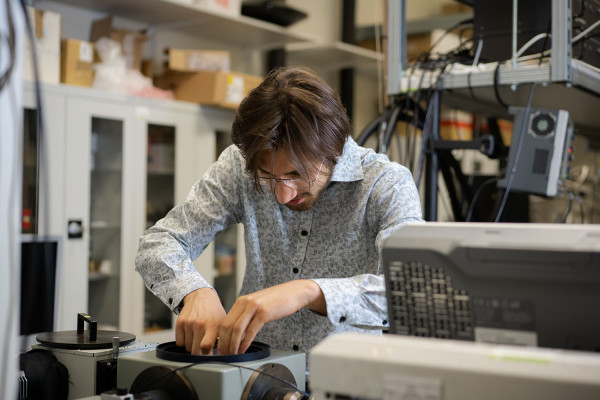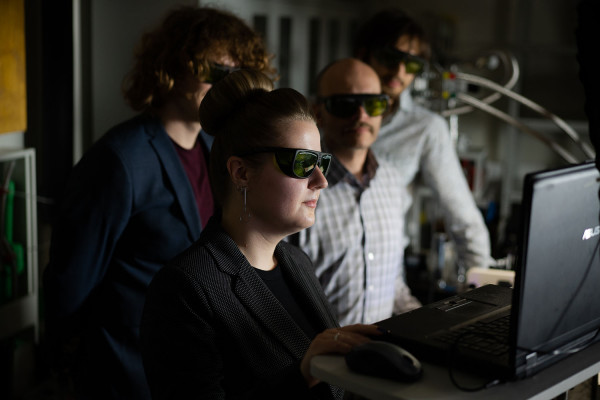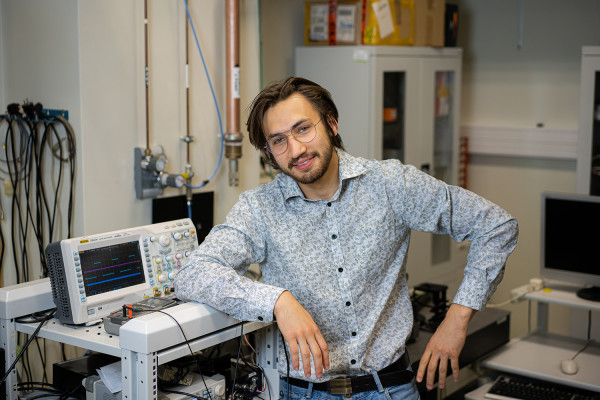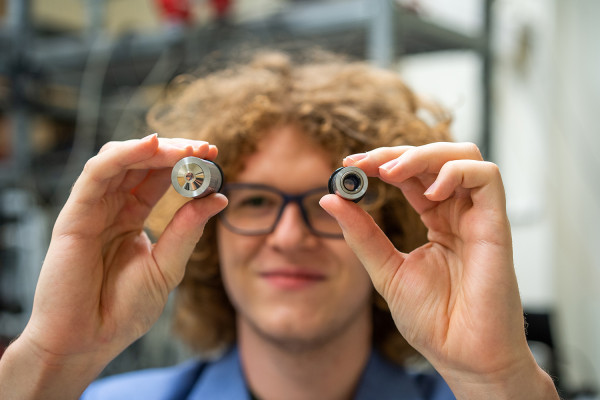Ultrafast Phenomena Laboratory (UPL)

Team leader
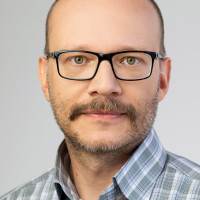
-
ORCID ID: 0000-0002-1065-6770
22 55 32 733
Research topics
In the Laboratory of Ultrafast Processes, we use ultrashort laser light pulses to study phenomena occurring in matter after optical excitation.
We can track processes (e.g., structural changes, reorganization of chemical bonds) taking place in organic molecules or nanoparticles made from inorganic materials after photon absorption, or induce nonlinear phenomena, such as the simultaneous absorption of multiple photons or the frequency change of the laser light wave. Based on these capabilities, we aim to develop new photoactive materials (e.g., for emission) and to create methods for detecting pathological substances in tissues. We are also planning to begin research on the interaction of quantum states of light with matter.
The laboratory offers opportunities to conduct undergraduate, master's, and doctoral projects related to ongoing research.
Members

-
ORCID ID: 0000-0002-1460-8477
22 55 32 735

-
Paulina Rajchel - Mieldzioć, MSc
ORCID ID: 0000-0002-0670-3159
22 55 32 710

-
ORCID ID: 0000-0002-6222-6561
22 55 32 735
Photophysics of photoactive materials
We study the photophysical properties of new photoactive materials, such as structures that emit circularly polarized light, nanoparticles that convert infrared light into visible light, or dyes for two-photon-excited lasing, using stationary and time-resolved spectroscopic techniques. By analyzing the interaction of these materials with light and examining the influence of their environment on their photophysics, we can understand the mechanisms underlying their behavior and contribute to the optimization of the properties of new materials.
Dynamics of processes in organic molecules
The formation and breaking of chemical bonds, as well as structural changes in chemical molecules, occur in times much shorter than one picosecond. The study of such fast phenomena is only possible by using ultrashort laser light pulses lasting femtoseconds: one pulse can initiate the process under investigation, while another pulse, delayed by a set amount of time, monitors its progress. Using this scheme, we study the dynamics of elementary chemical reactions, such as hydrogen atom transfer, which allows us, among other things, to verify quantum models used to describe them.
Lasing and nonlinear optics in biological materials
Until now, light has rarely been considered in the context of diagnostic methods that could be used for imaging tissues in forms other than biopsy samples viewed under a microscope. This is due to the strong scattering of light by tissues and the low sensitivity of light to microscopic changes occurring within tissues. This situation is now changing, thanks to the development of techniques that overcome scattering and allow light to be focused deep within tissues, as well as advancements in methods based on nonlinear (multiphoton) light absorption and stimulated emission processes. By utilizing the properties of ultrashort light pulses, we are developing methods for detecting pathogenic proteins in tissues, based on, for example, the generation of laser light within the tissue under examination or stimulated emission microscopy.
Spectroscopy with quantum light
Rapidly developing quantum technologies may lead to groundbreaking inventions, such as the quantum computer, and breakthroughs in areas such as computing, telecommunications, and metrology. In recent years, there has been intensive work on developing methods for generating and modifying quantum states of light, but surprisingly little is known about the interaction of such light states with matter. We are currently working on building a source of entangled light states that can be used in spectroscopic experiments, including time-resolved measurements, where femtosecond time resolution can be achieved without the use of femtosecond laser pulse sources.
2025
Sens. Actuator A-Phys. 394, 116909
- S. Khodami
- M. Gharakhloo
- S. Dagdelen
- P. Fita
- M. Karbarz
- Z. Stojek
2025
ACS Photonics, 12, 1392–1401
Transient Absorption Microscopy for Early-Stage Imaging of Protein Aggregates Using Thioflavin T
2024
ACS Appl. Mater. Interfaces 16, 57659–57671
- S. Khodami
- M. Gharakhloo
- S. Dagdelen
- P. Fita
- J. Romanski
- M. Karbarz
- Z. Stojek
- M. Mackiewicz
2024
Nanophotonics 13, 2659–2668
Electrical polarization switching of perovskite polariton laser
- K. Łempicka-Mirek
- M. Król
- L. De Marco
- A. Corialono
- I. Viola
- M. Kędziora
- M. Muszyński
- P. Morawiak
- R. Mazur
- P. Kula
- W. Piecek
- P. Fita
- D. Sanvitto
- J. Szczytko
- B. Piętka
2024
J. Phys. Chem. Lett. 15, 3982-3986 (2024)
2023
J. Mater. Chem. C 11, 4937-4945
One- and two-photon lasing from a TCF-based AIE dye
- K. Lupinska
- M. Durko-Maciag
- C. Andraud
- Y. Bretonniere
- P. Hańczyc
- P. Fita
- P. Szulim
- J. Myśliwiec
- L. Sznitko
2022
J. Photochem. Photobiol. B: Biology 228, 112392
Two-photon excited lasing for detection of amyloids in brain tissue
2022
Journal of Colloid and Interface Science 608
- Pastorczak/ Marcin
- Nejbauer/Michał
- Shinyashiki / Naoki
- Takatsuka/ Masanobu
- Angulo/ Gonzalo
- Stepanenko / Yuriy
- C. Radzewicz
2021
ACS Photonics, 8, 2598-2609
Laser Emission of Thioflavin T Uncovers Protein Aggregation in Amyloid Nucleation Phase
2021
Int. J. Mol. Sci. 22,2661
- M. Prokopowicz
- A. Jarmuła
- Y. Casamayou-Boucau
- A. Gordon
- F. Ryder
- J. Sobich
- P. Maj
- Z. Cieśla
- J. Zieliński
- P. Fita
- W. Rode
2021
ACS Sustainable Chemistry & Engineering
Air−Water Interface Assembly of Protein Nanofibrils Promoted by Hydrophobic Additives
- Lei Wang
- F.G.Backlund
- Yusheng Yuan
- Serlvan Kumaran
- P. Hańczyc
- L.Sznitko
- Niclas Solin
2020
Phys. Chem. Chem. Phys. 22, 17117-17128
Influence of local microenvironment on the double hydrogen transfer in porphycene
- P. Kasprzycki
- P. Kopycki
- A. Listkowski
- A. Gorski
- C. Radzewicz
- D. J. S. Birch
- J. Waluk
- P. Fita
2020
ChemPlusChem 85, 2197-2206
Fluorinated Porphycenes: Synthesis, Spectroscopy, Photophysics, and Tautomerism
- A. Listkowski
- A. Kharchenko
- P. Ciąćka
- M. Kijak
- N. Masiera
- R. Rybakiewicz
- R. Luboradzki
- P. Fita
- J. Waluk
2020
Optics Letters. 45, 1563-1566
Raman-induced pulse destabilization and bistability in an all-normal dispersion oscillator
- J. Szczepanek
- T. M. Kardaś
- C. Radzewicz
- Y. Stepanenko
2020
J. Mol. Struct. 1203, 127371
Spectroscopic and quantum chemical study of phthalocyanines with 1,4,7-trioxanonyl moieties
- M. Wierzchowski
- Ł. Sobotta
- D. Łażewski
- P. Kasprzycki
- P. Fita
- T. Goslinski
2020
Ultrason. Sonochem. 63, 104912
Reaction kinetics of sonochemical oxidation of potassium hexacyanoferrate(II) in aqueous solutions
- P. Rajchel - Mieldzioć
- R. Tymkiewicz
- J. Sołek
- W. Secomski
- J. Litniewski
- P. Fita
2019
New J. Chem. 43, 6728-6736
- A. Popczyk
- Y. Cheret
- A. Grabarz
- P. Hańczyc
- P. Fita
- A. El-Ghayoury
- L. Sznitko
- J. Mysliwiec
- B. Sahraoui
2019
Chem. Eur. J. 15, 4851–4856
Ground- and Excited-State Tautomerization Rates in Porphycenes
- P. Fita
- N. Urbańska
- C. Radzewicz
- J. Waluk
2019
J. Biophotonics 12, e201900052
Two-photon excited lasing of coumarine 307 for lysozyme amyloid fibrils detection
- P. Hańczyc
- M. Procyk
- C. Radzewicz
- P. Fita
2018
J. Mater. Chem. C 6, 4384-4388
- A. Justyniarski
- J. K. Zaręba
- P. Hańczyc
- P. Fita
- M. Chołuj
- R. Zaleśny
- M. Samoć
2018
Scientific Reports 8, 14350
Noncollinear and nonlinear pulse propagation
- T. M. Kardaś
- Y. Stepanenko
- C. Radzewicz
2018
Journal of Photochemistry and Photobiology B: Biology 183, 111–118
- L. Sobotta
- J. Dlugaszewskab
- P. Kasprzycki
- S. Lijewskid
- A. Teuberte
- J. Mielcareka
- M. Gdaniec
- T. Goslinskid
- P. Fita
- E.Tykarskad
2017
Proc. SPIE 100941
Study of parameters of fiber loop mirrors as artifacial saturable absorbers)
- W. Stępień
- J. Szczepanek
- T. Kardaś
- M. Nejbauer
- C. Radzewicz
- Y. Stepanenko
2017
NanoLetters 17, 2652-2659
- J. Oracz
- K. Adolfsson
- V. Westphal
- C. Radzewicz
- M. T. Borgström
- S. J. Sahl
- Ch. N. Prinz
- S. W. Hell
2017
The Journal of Chemical Physics 146, 244505 (2017)
- G. Angulo
- J. Jedrak
- A. Ochab-Marcinek
- P. Pasitsuparoad
- C. Radzewicz
- P. Wnuk
- A. Rosspeintner
2017
Phys.Chem. 19, 4921-4937
- P. Fita
- L. Grill
- A. Listkowski
- H. Piwonski
- S. Gawinkowski
- M. Pszona
- J. Sepioł
- E. Mengesha
- T. Kumagai
- J. Waluk
2017
Phys.Chem.Chem.Phys. 19, 6274-6285
- G. Angulo
- J. Milkiewicz
- D. Kattnig
- M. Nejbauer
- Y. Stepanenko
- J. Szczepanek
- C. Radzewicz
- P. Wnuk
- G. Grampp
2017
Chem. Phys. 19, 21390
- P. Kasprzycki
- L. Sobotta
- S. Lijewski
- M. Wierzchowski
- T. Goslinski
- J. Mielcarek
- C. Radzewicz
- P. Fita
2017
Phys Chem Chem Phys. 16;19(32):21390-21400
- P. Kasprzycki
- L. Sobotta
- S. Lijewski
- M. Wierzchowski
- T. Goslinski
- J. Mielcarek
- C. Radzewicz
- P. Fita
2017
Opt Express. 24;25(15):18017-18023
Low noise, self-referenced all polarization maintaining Ytterbium fiber laser frequency comb
- Li Y
- N. Kuse
- A. Rolland
- Y. Stepanenko
- C. Radzewicz
- M. E. Fermann
2016
Proc. SPIE 10031, 1003134
Development of implantable light source for optogenetics
- K. Rusakov
- C. Radzewicz
2016
Opt. Lett. 41, 2394-2397
Spectral compression of femtosecond pulses using chirped volume Bragg gratings
- M. Nejbauer
- T. Kardaś
- Y. Stepanenko
- C. Radzewicz
2016
Opt. Lett. 41, 2394-2397
Spectral compression for semtosecond pulses using chirped volume Bragg gratings
- M. Nejbauer
- T. M. Kardaś
- Y. Stepanenko
- C. Radzewicz
2016
Phys.Chem Chem.Phys. 18, 18460-18469
- G. Angulo
- M. Brucka
- M. Gerecke
- G. Grampp
- D. Jeannerat
- J. Milkiewicz
- Y. Mitrev
- C. Radzewicz
- A. Rosspeintner
- E. Vauthey
- P. Wnuk
2016
Optics Letters 41, 2394
Spectral compression of femtosecond pulses using chirped volume Bragg grating
- M. Nejbauer
- T.M. Kardaś
- Y. Stepanenko
- C. Radzewicz
2015
Optics Letters 40, 3500-3503
Simple all-PM-fiber laser mode-locked with nonlinear loop mirror
- J. Szczepanek
- T. Kardaś
- M. Michalska
- C. Radzewicz
- Y. Stepanenko
2015
Proc. SPIE 9513, 19-20
Different mode-locking methods in high energy all-normal dispersion YB femtosecond all-fiber lasers
- J. Szczepanek
- M. Michalska
- T. Kardaś
- C. Radzewicz
- Y. Stepanenko
2015
Photon.Lett. PL 7, 75-77
Control of electronic populations in porphycene with chirped ultrashort pulses
- P. Ciąćka
- P. Fita
- C. Radzewicz
2015
Chem. Eur. J.21, 1312-1327
Substituent and solvent effects on the excited state deactivation channels an anils and boranils
- J. Dobkowski
- P. Wnuk
- J. Buczyńska
- M. Pszona
- G. Orzanowska
- D. Frath
- G. Ulrich
- J. Massue
- S. Mosquera-Vazquez
- E. Vauthney
- C. Radzewicz
- R. Ziessel
- J. Waluk
2015
Scientific Reports 5, 17495-17503
- P. Morzyński
- M. Bober
- D. Bartoszek-Bober
- J. Nawrocki
- P. Krehlik
- Ł. Sliwczyński
- M. Lipiński
- P. Masłowski
- A. Cygan
- P. Dunst
- M. Garus
- D. Lisak
- J. Zachorowski
- W. Gawlik
- C. Radzewicz
- R. Ciuryło
- M. Zawada
2015
J.Che.Phys. B 119, 2292-2301
Tautomerism in porphycenes: Analysis of rate-affecting factors
- P. Ciąćka
- P. Fita
- A. Listkowski
- M. Kijak
- S. Nonell
- D. Kuzuhara
- H. Yamada
- C. Radzewicz
- J. Waluk
2014
Optical and Quantum Electronics 46, 563-571
Mid-infrared supercontinuum generation in soft-glass suspended core photonic crystal fiber
- M. Klimczak
- B. Siwicki
- P. Skibinski
- D. Pysz
- R. Stepien
- A. Szolno
- J. Pniewski
- C. Radzewicz
- R. Buczynski
2014
Optics Express 22, 18824-18832
- M. Klimczak
- B. Siwicki
- P. Skibiński
- D. Pysz
- R. Stępień
- A. Heidt
- C. Radzewicz
- R. Buczyński
2014
Phys. Rev. A 90, 033836
Linear optics schemes for entanglement distribution with realistic single-photon sources
- M. Lasota
- C. Radzewicz
- K. Banaszek
- R. Thew
2014
J. Phys. Chem. C 118, 23147–23153
2014
Opt. Commun. 317, 1-6
How to measure diffusional decoherence in multimode Rubidium vapor memories?
- R. Chrapkiewicz
- W. Wasilewski
- C. Radzewicz
2014
Phot. Lett. PL 6, 8-10
Femtosecond fiber CPA system in a single pass configuration
- M. Laskownicki
- J. Szczepanek
- Y. Stepanenko
- P. Wasylczyk
- M. Nejbauer
- C. Radzewicz
2013
J. Photochem. Photobiol. A: Chemistry 269, 9–16
- L. Sobotta
- P. Fita
- W. Szczolko
- M. Wrotynski
- M. Wierzchowski
- T. Goslinski
- J. Mielcarek
2013
Inorg. Chem. Commun. 27, 56–59
- M. Kryjewski
- M. Nowak
- P. Kasprzycki
- P. Fita
- C. Radzewicz
- T. Gosliński
- J. Mielcarek
2013
J. Phys. Chem. A 117, 4136–4147
Excited-State Dynamics of Ethyl 5-(4-Aminophenyl)-3-Amino-2,4-Dicyanobenzoate
- M. Józefowicz
- P. Fita
- P. Kasprzycki
- J. R. Heldt
2013
Nature Commun. 4, 2594
Quantum mechanical which-way experiment with an internal degree of freedom
- K. Banaszek
- P. Horodecki
- M. Karpiński
- C. Radzewicz
2013
Eur. Phys. J. Special Topics 222, 2119-2142
- A. Cygan
- S. Wójtewicz
- J. Domysławska
- P. Masłowski
- K. Bielska
- M. Piwiński
- K. Stec
- R. S. Trawiński
- F. Ozimek
- C. Radzewicz
- H. Abe
- T. Ido
- J. T. Hodges
- D. Lisak
- R. Ciuryło
2013
Opt. Lett. 38, 22
Absolute frequency measurement of rubidium 5S-7S two-photon transitions
- P. Morzyński
- P. Wcisło
- P. Ablewski
- R. Gartman
- W. Gawlik
- P. Masłowski
- B. Nagórny
- F. Ozimek
- C. Radzewicz
- M. Witkowski
- R. Ciuryło
- M. Zawada
2013
Proc.SPIE 8902, 890215
Octave spanning supercontinuum in normal dispersion photonic crystal fiber
- B. Siwicki
- M. Klimczak
- P. Skibiński
- T. Martynkien
- D. Pysz
- R. Stępień
- A. Szołno
- C. Radzewicz
- R. Buczyński
2013
Inorganic Chemistry Communications 27, 56-59
- M. Kryjewski
- M. Nowak
- P. Kasprzycki
- P. Fita
- C. Radzewicz
- T. Gosliński
- J .Mielcarek
2013
Z. Phys. Chem. 227, 1009–1020
Double hydrogen transfer in low symmetry porphycenes
- P. Fita
- P. Ciąćka
- I. Czerski
- M. Pietraszkiewicz
- C. Radzewicz
2012
J. of Chemical Physics 136, 024201
- J. Domysławska
- S. Wójtewicz
- D. Lisak
- A. Cygan
- F. Ozimek
- K. Stec
- C. Radzewicz
- R. Trawiński
- R. Ciurył
2012
J. Chem. Phys. 136, 024201
- J. Domysławska
- S. Wójtewicz
- D. Lisak
- A. Cygan
- F. Ozimek
- K. Stec
- C. Radzewicz
- R. S. Trawiński
- R. Ciuryło
2012
J. Photochem. Photobiol. A: Chem. 234, 100–106
The dynamics and origin of the unrelaxed fluorescence of free-base tetraphenylporphyrin
- B. Białkowski
- Y. Stepanenko
- M. Nejbauer
- C. Radzewicz
- J. Waluk
2012
Bulletin of the Polish Academy of Sciences, Technical Sciences 60, 4
Precision Spectroscopy of Cold Strontium Atoms, Towards Optical Atomic Clock
- M. Bober
- J. Zachorowski
- W. Gawlik
- P. Morzyński
- M. Zawada
- D. Lisak
- A. Cygan
- K. Bielska
- M. Piwiński
- R.S. Trawiński
- R. Ciuryło
- F. Ozimek
- C. Radzewicz
2012
Chem. ‒ Eur. J. 18, 13160–13167
- P. Fita
- M. Pszona
- G. Orzanowska
- D. Sánchez-García
- S. Nonell
- E. Vauthey
- J. Waluk
2012
J. Photochem. Photobiol. A: Chem. 232, 44–49
Femtosecond studies of the excited-state dynamics of ester-alkyloxy substituted zinc phthalocyanines
- P. Fita
- T. Osmałek
- T. Gosliński
- M. Wierzchowski
- J. Mielcarek
2012
Tetrahedron Lett. 53, 2040–2044
- W. Szczolko
- L. Sobotta
- P. Fita
- T. Koczorowski
- M. Mikus
- M. Gdaniec
- A. Orzechowska
- K. Burda
- S. Sobiak
- M. Wierzchowski
- J. Mielcarek
- E. Tykarska
- T. Goslinski
2011
Langmuir 27, 4645
Hydrogen-Bond-Assisted Excited-State Deactivation at Liquid/Water Interfaces
- P. Fita
- M. Fedoseeva
- E. Vauthey
2011
Polyhedron, 30, 1538–1546
- T. Gośliński
- T. Osmałek
- K. Konopka
- M. Wierzchowski
- P. Fita
- J. Mielcarek
2010
J. of American Chemical Society 132 13472-13485
Unusual solvent viscosity-controlled tautomerismand photophysics: meso-alkylated porphycenes
- M. Gil
- J. Dobkowski
- G. Wiosna-Sańga
- N. Urbańska
- P. Fita
- M. Pietraszkiewicz
- C. Radzewicz
- P. Borowicz
- D. Marks
- M. Glasbeek
- J. Waluk
2010
J. Am. Chem. Soc. 132, 13472–13485
Unusual, Solvent Viscosity-Controlled Tautomerism and Photophysics: Meso-Alkylated Porphycenes
- M. Gil
- J. Dobkowski
- G. Wiosna-Sałyga
- N. Urbańska
- P. Fita
- C. Radzewicz
- M. Pietraszkiewicz
- P. Borowicz
- D. Marks
- M. Glasbeek
- J. Waluk
2010
Opt. Commun. 283, 713–718
Quantum and semiclassical polarization correlations
- K. Banaszek
- R. Demkowicz-Dobrzański
- M. Karpiński
- P. Migdał
- C. Radzewicz
2009
Opt. Commun. 282, 4361–4365
Broadband near-infrared fibers dispersion measurement using white-light spectral interferometry
- T. M. Kardaś
- C. Radzewicz
2009
Rev. Sci. Instrum. 80, 083101
Collinear interferometer with variable delay for carrier-envelope offset frequency measurement
- M. Pawłowska
- F. Ozimek
- P. Fita
- C. Radzewicz
2009
Appl. Phys. Lett. 94, 181105
Experimental characterization of three-wave mixing in a multimode nonlinear KTiOPO4 waveguide
- M. Karpiński
- C. Radzewicz
- K. Banaszek
2009
Opt. Express 17, 4652–4658
Coherent nonlinear emission from a single KTP nanoparticle with broadband femtosecond pulses
- P. Wnuk
- L. L. Xuan
- A. Slablab
- C. Tard
- S. Perruchas
- T. Gacoin
- J. Roch
- D. Chauvat
- C. Radzewicz
2009
Opt. Express 17, 5630
Passively modelocked, diode-pumped Yb:KYW femtosecond oscillator with 1 GHz repetition rate
- P. Wasylczyk
- P. Wnuk
- C. Radzewicz
2008
J. Phys. Chem. A 112, 10753
Electronic and vibrational relaxation of porphycene in solution
- P. Fita
- C. Radzewicz
- J. Waluk
2008
Am. J. Phys. 76, 229
Wavefront sensor with Fresnel zone plates for use in an undergraduate laboratory
- P. Migdał
- P. Fita
- L. Mazurek
- C. Radzewicz
2008
Z. Phys. Chem. 222, 1165–1173
Unusually Slow Intermolecular Proton-Deuteron Exchange in Porphycene
- P. Fita
- N. Urbańska
- C. Radzewicz
- J. Waluk
2008
Phys. Rev. A 78 033831
Statistics of multiphoton events in spontaneous parametric down-conversion
- W. Wasilewski
- C. Radzewicz
- R. Frankowski
- K. Banaszek
2008
J. Opt. Soc. Am. B 25, 1625–1626
2008
J. Opt. Soc. Am. B 24, 668–673
Fiber-optic realization of anisotropic depolarizing quantum channels
- M. Karpiński
- K. Banaszek
- C. Radzewicz
2007
Phys. Rev. Lett. 98, 063901
Time-frequency domain analogues of phase space sub-Planck structures
- L. Praxmeyer
- P. Wasylczyk
- K. Wykiewicz
- C. Radzewicz
2007
Opt. Commun. 272, 496
Coherent control and dark pulses in second harmonic generation
- P. Wnuk
- C. Radzewicz
2007
J. Chem. Phys. 126, 184708
Ultrafast optical Kerr effect spectroscopy of water confined in nanopores of the gelatin gel
- B. Ratajska-Gadomska
- B. Białkowski
- W. Gadomski
- C. Radzewicz
2006
Chem. Phys. Lett. 429, 575
Ultrashort Memory of the Quasicrystaline Order in Water by Optical Kerr Effect Spectroscopy
- B. Ratajska-Gadomska
- B. Białkowski
- W. Gadomski
- C. Radzewicz
2006
Phys. Rev. A 73, 063819
Pulsed squeezed light: simultaneous squeezing of multiple modes
- W. Wasilewski
- A. I. Lvovsky
- K. Banaszek
- C. Radzewicz
2006
Opt. Express 14, 779
Multipass non-collinear optical parametric amplifier for femtosecond pulses
- Y. Stepanenko
- C. Radzewicz
2006
Opt. Lett. 31, 1130
Joint spectrum of photon pairs measured by coincidence Fourier spectroscopy
- W. Wasilewski
- P. Wasylczyk
- P. Kolenderski
- K. Banaszek
- C. Radzewicz
2005
Appl. Phys. Lett. 86, 021910
Femtosecond transient fluorescence spectrometer based on parametric amplification
- P. Fita
- Y. Stepanenko
- C. Radzewicz
2005
Chem. Phys. Lett. 416, 305
- P. Fita
- E. Luzina
- T. Dziembowska
- D. Kopeć
- P. Piątkowski
- C. Radzewicz
- A. Grabowska
2005
Proc. SPIE 5949, 59491-M
Observation of critical self focusing during propagation of femtosecond light pulses in bulk media
- P. Wasylczyk
- W. Wasilewski
- M. Trippenbach
- C. Radzewicz
2005
Appl. Phys. Lett. 86, 211120
High gain multipass non-collinear optical parametric chirped pulse amplifier
- Y. Stepanenko
- C. Radzewicz
2005
Opt. Express 13, 4154
Bimorph piezo deformable mirror for femtosecond pulse shaping
- P. Wnuk
- C. Radzewicz
- J. Krasiński
2005
Opt. Lett. 30, 1704
A broadband noncollinear optical parametric amplifier using a single crystal
- P. Wasylczyk
- I. A. Walmsley
- W. Wasilewski
- C. Radzewicz
2005
Opt. Commun. 246, 569
- M. Szkulmowski
- M. Wojtkowski
- T. Bajraszewski
- I. Górczyńska
- P. Targowski
- W. Wasilewski
- P. Kowalczyk
- C. Radzewicz
2004
Am. J. Ophthalmol. 138, 412
Ophthalmic Imaging by Spectral Optical Coherence Tomography
- M. Wojtkowski
- T. Bajraszewski
- I. Górczyńska
- P. Targowski
- A. Kowalczyk
- W. Wasilewski
- C. Radzewicz
2004
Rev. Sci. Instr. 75, 2482
A single-shot autocorrelator based on a Babinet compensator
- P. Wasylczyk
- W. Wasilewski
- C. Radzewicz
2004
Appl. Phys. B 78, 589
Femtosecond laser pulses measured with a photodiode - FROG revisited
- W. Wasilewski
- P. Wasylczyk
- C. Radzewicz
2004
Opt. Lett. 29, 177
Piezo-driven deformable mirror for femtosecond pulse shaping
- C. Radzewicz
- P. Wasylczyk
- W. Wasilewski
- J. S. Krasiński
2003
Proc. SPIE Vol. 4992, 55
Propagation of ultrashort laser pulses through transparent dielectrics in nonlinear regime
- C. Radzewicz
- W. Wasilewski
- P. Wasylczyk
- M. Trippenbach
- J. S. Krasiński
2003
Proc. SPIE Vol. 5258, 20
Nonlinear propagation of femtosecond laser pulses in dielectrics
- P. Wasylczyk
- W. Wasilewski
- M. Matuszewski
- M. Trippenbach
- C. Radzewicz
2002
Acta Physica Polonica 101, 89
Nonlinear Effects with Ultrashort Laser Pulses
- P. Wasylczyk
- W. Wasilewski
- M. Trippenbach
- C. Radzewicz
2001
Optoelectronics Rev. 9, 308
Generation and diagnostics of femtosecond light pulses
- C. Radzewicz
- P. Wasylczyk
- J. S. Krasiński

